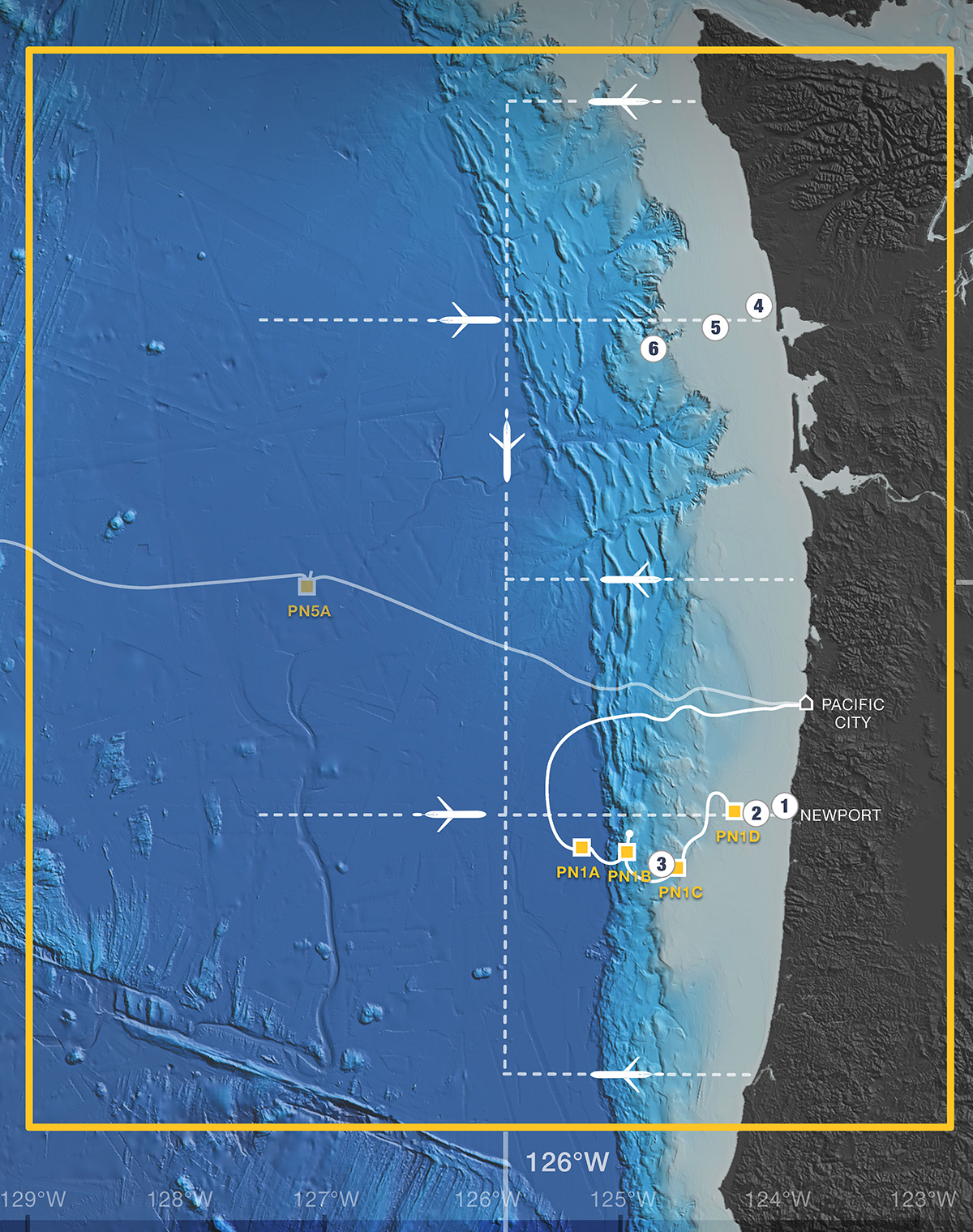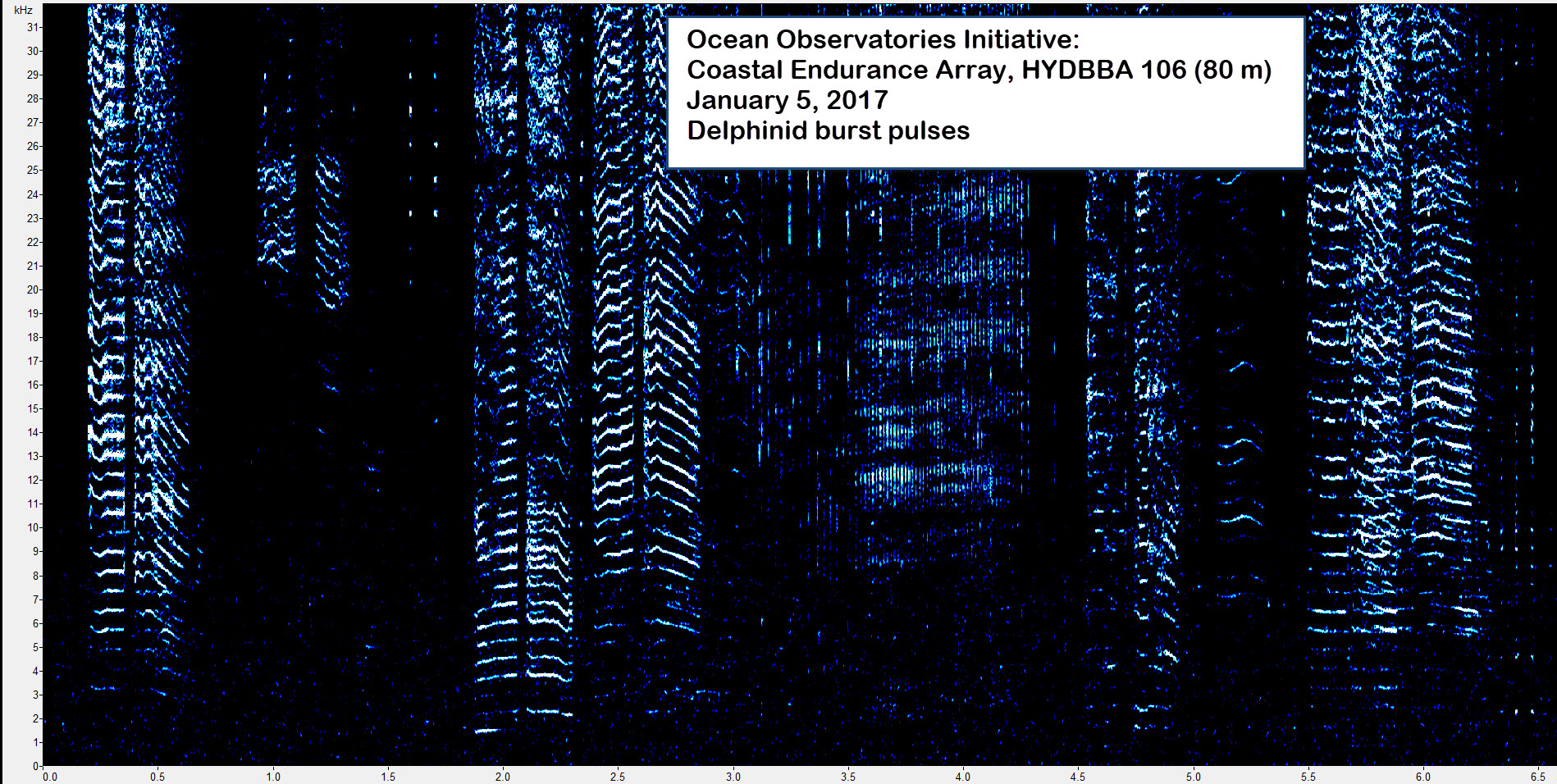Early Adopter

Applied Research Topic
Potential Applications ► Ocean mammal tracking (migration & feeding), climate change assessment
Description
The coastal waters off Newport, Oregon are part of an ecologically dynamic environment influenced by the California Current System (CCS). In additional to the seasonal, interannual and decadal processes that influence this system, recent monitoring of the CCS has revealed the presence of persistent warm water masses that have profoundly impacted ecosystems at local and regional scales. One method of assessing long standing shifts in the ecology of this coastal and offshore environment is to associate physical and biochemical oceanographic variables with the presence of marine mammal indicator species including whales and dolphins. The sustained, long-term time series collected by the Ocean Observatories Initiative (OOI) Endurance and Regional Cabled arrays located off the Oregon coast include broadband hydrophone, water temperature, dissolved oxygen, pH, pCO2, chlorophyll, and nitrate observations. These physical and biological data are collected by fixed (moorings and benthic landers) and mobile (gliders and profilers) platforms. Passive acoustic data collected by the OOI can be analyzed to determine the presence of vocally active marine mammal species and identify their spatial and temporal use of the Oregon continental shelf. This information can be combined with the physical oceanographic variables to assess the ecological characteristics associated with marine mammal occurrence. The Coastal and Offshore Oregon Marine Mammal Ecological Study project is a cross-platform study that combines OOI data with remotely sensed observations to provide new insights into recent northern CSS ecological conditions. Ultimately this project will contribute to evaluating future coastal and offshore ecosystem changes. ArcGIS Storymaps will be created to communicate scientific outcomes to the general public, and an online training course will be developed to train others in the project methods.Significance
The relevance of this project falls within two important categories: overall ocean health monitoring (related to climate change) and commercial and recreational fishing industries. Large scale oceanic changes can impact society in a variety of ways, including effects such as sea level rise and changes in localized climate. This project serves as an important environmental assessment of those changes occurring within the California Current Ecosystem. Specifically, we will connect PACE measurements to marine mammal indicator species using hydrophone data, allowing for a deeper understanding of how ecosystem changes impact these animals. Secondly, shifts in the ecosystem play a crucial part in the composition of fish communities within this region. Along with shifting environmental variables comes a change in the populations that inhabit historically successful fishing grounds. Continuous monitoring of this region would likely be of interest to local fishermen as well as recreational fishing industries. Finally, the use of OOI data also allows for validation of PACE data through in situ oceanographic observations inside the study area.Why PACE
The PACE Mission provides the opportunity to incorporate a fundamental piece of the ecosystem web through the provision of information on phytoplankton and algal communities. The proposed project can directly measure physical and biochemical oceanographic variables as well as the presence of marine mammals, but primary producers are only indirectly monitored through chlorophyll observations. Through large scale observations of photosynthesizing organisms, we will be able to incorporate direct measurements of the presence and distributions of these key ecosystem trophic level contributors. To that extent the PACE data will be extremely valuable for providing regional context to the OOI observations, which tend to be from fixed locations. This will contribute to a better understanding of the spatial and temporal distribution and ecosystem drivers of marine indicator species.End User(s)
Commercial & recreational fishing industry; online training communitySAT Partner(s)
Toby WestberryPublications
Ferguson, E. (2019). Applications for marine mammal studies using passive acoustic data from the Coastal Endurance array off Newport, Oregon. The Journal of the Acoustical Society of America, 146(4), 2770-2770. DOI: https://doi.org/10.1121/1.5136596.
Barth J.A., S.E. Allen, E.P. Dever, R.K. Dewey, W. Evans, R.A. Feely, J.L. Fisher, J.P Fram, B.R. Hales, D. Ianson, J. Jackson, S.K. Juniper, O. Kawka, D. Kelley, J.M. Klymak, J. Konovsky, P.M. Kosro, A. Kurapov, E. Mayorga, P. MacCready, J.A. Newton, R.I. Perry, C.M. Risien, M. Robert, T. Ross, R.K. Shearman, J. Schumacker, S. Siedlecki, V.L. Trainer, S. Waterman, and C.E. Wingard (2019). Better Regional Ocean Observing through Cross-National Cooperation: A Case Study from the Northeast Pacific, Frontiers in Marine Science, DOI: https://doi.org/10.3389/fmars.2019.00093.
Peterson, W.T., J. Fisher, P.T. Strub, X. Du, C. Risien, J. Peterson, and T. Shaw (2017). The pelagic ecosystem in the northern California Current off Oregon during the 2014-2016 warm anomalies within the context of the past 20 years, Journal of Geophysical Research, DOI: https://doi.org/10.1002/2017JC012952.



